
EBK Home
Kingdoms
Royalty
Saints
Pedigrees
Archaeology
King Arthur
Adversaries
For Kids
Mail David
The Old Minster, Winchester
Founded in AD 648
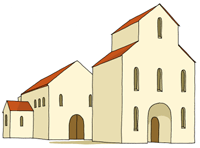 Christianity
had been established in the Kingdom of Wessex for only fifteen years, when
King Cenwalh of Wessex invited its evangelist, St. Birinus, to build a
minster church adjoining his Royal palace in Winchester. Sadly, there is
no truth to the old story that the mythical King Lucius of Britain had
beaten him to it in the 2nd century. If the cathedral at Dorchester-on-Thames was a
wooden building, Winchester's church may have been the first stone
building erected in the kingdom since the departure of the Roman
administration. Perhaps, masons had arrived from Italy or Frankia to help
Birinus by this time. Certainly, a 72 foot long two-celled building with
square side chapels or 'portici' (the northernmost being a baptistry) was soon constructed of reused Roman
stone and dedicated to SS. Peter & Paul. Traditionally, King Cenwalh
immediately granted it all the land surrounding the town walls, known as
the Chilcomb Estate.
Christianity
had been established in the Kingdom of Wessex for only fifteen years, when
King Cenwalh of Wessex invited its evangelist, St. Birinus, to build a
minster church adjoining his Royal palace in Winchester. Sadly, there is
no truth to the old story that the mythical King Lucius of Britain had
beaten him to it in the 2nd century. If the cathedral at Dorchester-on-Thames was a
wooden building, Winchester's church may have been the first stone
building erected in the kingdom since the departure of the Roman
administration. Perhaps, masons had arrived from Italy or Frankia to help
Birinus by this time. Certainly, a 72 foot long two-celled building with
square side chapels or 'portici' (the northernmost being a baptistry) was soon constructed of reused Roman
stone and dedicated to SS. Peter & Paul. Traditionally, King Cenwalh
immediately granted it all the land surrounding the town walls, known as
the Chilcomb Estate.
Birinus' church was always later known as the 'Old Minster' and, in AD 660, ten years after his death, it became a cathedral church of its own diocese. Cenwalh had became frustrated with Birinus' Frankish successor who refused to learn Old English, so he split his bishopric in two. The regions were, in fact, reunited only three years later and the centre of the diocese returned to Dorchester. By AD 690, however, Bishop Haedda ordered the transference of his Episcopal throne to Winchester and consolidated both political and ecclesiastical control of the kingdom in this largely deserted Roman town. At the same time, Haedda translated Birinus' relics to his new cathedral, although Dorchester was to hotly dispute this in later years.
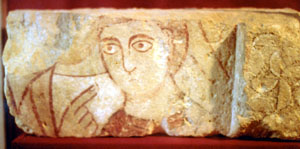 In the 8th century, probably during the
episcopate of Bishop Daniel, the cathedral's rectangular chancel was
rebuilt as an apse. At the same time, a small detached tower, dedicated to
St. Martin, was added immediately to the west. It had an arched walkway
through the centre to allow access from the cathedral directly to the
Royal palace opposite. It was in the middle of the path between the two
that the great St. Swithun was buried in AD 862. This successful bishop
had greatly raised both the profile and prosperity of his diocese and its
cathedral during a triumphant episcopate; and it may have been during his
time that the building acquired the coloured window glass, painted wall
decoration, beautiful carvings and multicoloured tiled floors which have been found during excavation.
In the 8th century, probably during the
episcopate of Bishop Daniel, the cathedral's rectangular chancel was
rebuilt as an apse. At the same time, a small detached tower, dedicated to
St. Martin, was added immediately to the west. It had an arched walkway
through the centre to allow access from the cathedral directly to the
Royal palace opposite. It was in the middle of the path between the two
that the great St. Swithun was buried in AD 862. This successful bishop
had greatly raised both the profile and prosperity of his diocese and its
cathedral during a triumphant episcopate; and it may have been during his
time that the building acquired the coloured window glass, painted wall
decoration, beautiful carvings and multicoloured tiled floors which have been found during excavation.
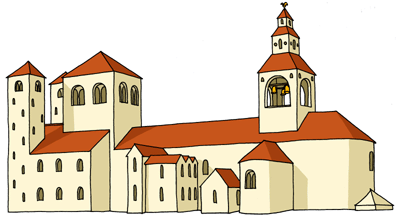 Late
in King Alfred's reign, steps were put in place for the founding of a new
Royal church at Winchester; and this 'New
Minster' was eventually erected
immediately to the north of the 'Old' for his son, King Edward
the Elder,
in AD 901. The two were so close that "the voices of the two choirs
confounded one another". The New Minster completely dominated the
scene, until AD 971, when the monastic reforms of Bishop Aethelwold meant
that many new buildings had to be raised for the Old Minster to fulfil its
role as a model of the Benedictine Order in England. It was to serve as both monastery and cathedral church,
a form known as a
"cathedral priory," unknown outside of England. As well as the usual
cloister, refectory and dormitories, Aethelwold provided a plumbing system
and surrounded the enclave with a new boundary wall after exchanging some
land with itself neighbouring rival. With so much construction work taking
place, Aethelwold evidently felt it was an ideal time to raise the profile
and, indeed, the complete façade of his cathedral. He translated St.
Swithun's bones to a rich shrine
displayed in the cathedral nave and erected a massive 100ft tower over the site of the old
grave; thus joining the cathedral to the
Late
in King Alfred's reign, steps were put in place for the founding of a new
Royal church at Winchester; and this 'New
Minster' was eventually erected
immediately to the north of the 'Old' for his son, King Edward
the Elder,
in AD 901. The two were so close that "the voices of the two choirs
confounded one another". The New Minster completely dominated the
scene, until AD 971, when the monastic reforms of Bishop Aethelwold meant
that many new buildings had to be raised for the Old Minster to fulfil its
role as a model of the Benedictine Order in England. It was to serve as both monastery and cathedral church,
a form known as a
"cathedral priory," unknown outside of England. As well as the usual
cloister, refectory and dormitories, Aethelwold provided a plumbing system
and surrounded the enclave with a new boundary wall after exchanging some
land with itself neighbouring rival. With so much construction work taking
place, Aethelwold evidently felt it was an ideal time to raise the profile
and, indeed, the complete façade of his cathedral. He translated St.
Swithun's bones to a rich shrine
displayed in the cathedral nave and erected a massive 100ft tower over the site of the old
grave; thus joining the cathedral to the 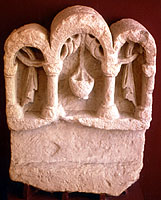 small tower of St. Martin. It had vast apsidal side chapel, forming a martyrium
bigger than Charlemagne's great octagon at Aachen. King
Edgar may have signed reforming Regularis Concordia here in
AD 973. A year later, probably while building work was
still incomplete, there was a change of plan however. St. Swithun's relics
were divided among a number of locations in the building, and the chapels were
demolished in favour of a great west front. It was a massive undertaking
of purely European inspiration which allowed the monarch to have his own
throne room in the cathedral's upper levels. From here he could both view
the mass being celebrated at the high-altar and be seen by his
subjects. Construction took six years and was dedicated in the
presence of King Aethelred
and the Archbishop of Canterbury
in AD 980. It was an outstanding structure, as shown by Cantor Wulfstan's
description of about 1005:
small tower of St. Martin. It had vast apsidal side chapel, forming a martyrium
bigger than Charlemagne's great octagon at Aachen. King
Edgar may have signed reforming Regularis Concordia here in
AD 973. A year later, probably while building work was
still incomplete, there was a change of plan however. St. Swithun's relics
were divided among a number of locations in the building, and the chapels were
demolished in favour of a great west front. It was a massive undertaking
of purely European inspiration which allowed the monarch to have his own
throne room in the cathedral's upper levels. From here he could both view
the mass being celebrated at the high-altar and be seen by his
subjects. Construction took six years and was dedicated in the
presence of King Aethelred
and the Archbishop of Canterbury
in AD 980. It was an outstanding structure, as shown by Cantor Wulfstan's
description of about 1005:
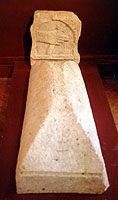 "He
[Aethelwold] also repaired the courts [atria] of this
ancient temple with lofty walls and new roofs, strengthening it in its
southern and northern parts with solid porticus and divers arches. He also
added many chapels with sacred altars which keep the entry of the
threshold doubtful, so that whoever walks in these courts [atria]
with unfamiliar tread cannot tell whence he comes or whither to return,
since open doors are seen on every hand, nor does any certain path of a
way appear. Standing he turns his wandering gaze hither and thither and is
amazed at the Attic roofs of the Daedalian floor, until a better informed
guide appears and leads him to the threshold of the furthest vestibule.
Here wondering in himself he crosses himself and cannot know in his
astonished breast from what place he is to get out."
"He
[Aethelwold] also repaired the courts [atria] of this
ancient temple with lofty walls and new roofs, strengthening it in its
southern and northern parts with solid porticus and divers arches. He also
added many chapels with sacred altars which keep the entry of the
threshold doubtful, so that whoever walks in these courts [atria]
with unfamiliar tread cannot tell whence he comes or whither to return,
since open doors are seen on every hand, nor does any certain path of a
way appear. Standing he turns his wandering gaze hither and thither and is
amazed at the Attic roofs of the Daedalian floor, until a better informed
guide appears and leads him to the threshold of the furthest vestibule.
Here wondering in himself he crosses himself and cannot know in his
astonished breast from what place he is to get out."
Aethelwold died in AD 984 and was probably buried in a great monolithic coffin excavated immediately to the north of the high-altar. It seems that it was his successor, St. Alphege, who began work on the church's eastern regions. Not to be outdone, he raised the floor of the nave, rebuilt the baptistry in marble, extended the chancel into a vast apse, raised the high-altar over a newly created crypt, built both rectangular and apsidal side chapels, as well as a five storied bell tower and a pyramidal mausoleum at the end. Inside there was apparently a great organ which needed seventy men to operate it. The church, almost certainly England's largest and finest, was dedicated in AD 994.
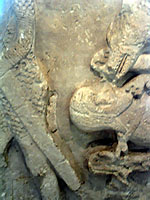 Many of the rulers of ancient Wessex,
as well as England, were
buried here, and their bones now lie in Mortuary Chests in the choir of
the cathedral. Cynegils (AD
643), Cenwalh (AD 674), Cynewulf (AD 786), Egbert
(AD 839), Aethelwulf (AD 858
but not translated until later), Alfred (temporarily in AD 899), Edred
(AD 955) and Canute (1035) were all buried there. Egbert was also crowned there in
AD
Many of the rulers of ancient Wessex,
as well as England, were
buried here, and their bones now lie in Mortuary Chests in the choir of
the cathedral. Cynegils (AD
643), Cenwalh (AD 674), Cynewulf (AD 786), Egbert
(AD 839), Aethelwulf (AD 858
but not translated until later), Alfred (temporarily in AD 899), Edred
(AD 955) and Canute (1035) were all buried there. Egbert was also crowned there in
AD 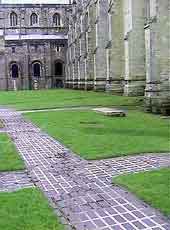 828.
In the late Saxon period, the joint ancestry of both the West Saxon and
Viking monarchs was even celebrated in a magnificent stone frieze carved
with episodes from the lives of their most notable forbears.
828.
In the late Saxon period, the joint ancestry of both the West Saxon and
Viking monarchs was even celebrated in a magnificent stone frieze carved
with episodes from the lives of their most notable forbears.
Shortly after the Conquest, though, the new Norman Bishop Wakelin was given the responsibility of building a completely new romanesque-style (Norman) cathedral (parts of which are still visible, today, mainly in the north and south transepts). In 1079 construction began and by 1093, the Old Minster was demolished, leaving only the outline of its foundations behind. The Old Minster, excavated in the 1960s, appears now only as a brick outline in the churchyard to the north of the existing cathedral building.
